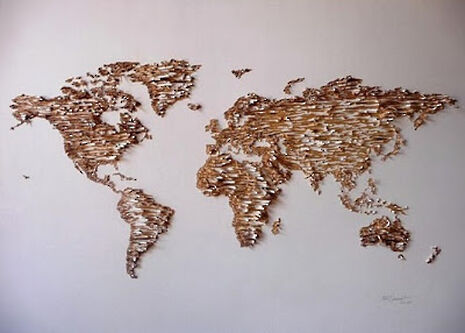Escaping the frame: the art of destruction
Meaning can be found in cracks, crevices and collisions, and often destruction in art can have as much impact as creation, observes Jade Cuttle

A crack is usually covered up, fixed and filled, the same goes for scuffs and scratches, smoothed over into oblivion. However, some artists such as Aurelien Maillard, shortlisted during the 2015 SLICK Art fair in Paris, see beauty in actively showcasing this imperfection. There is a sense of awe to his artwork, a mystery of magnificent proportions seen in the size of the scratches that span across his canvases. The claws of creativity seem massive and menacing: stood before its forceful mark the spectator fears he too may fall into its frightful clutches.
In some of Maillard's 'impact' artworks such as 'grey box' (2016), the cracks are edged into a corner of the canvas by the expanse of emptiness, lurking only in the outskirts of observation, but elsewhere they are less shy. In 'Untitled (semi-circular impact)' (2015) for instance, the constellation of cracks in a spider's web configuration stages itself in the spotlight, flaunting itself with the boldness of a canvas struck by thunder and lightning. However, it is 'Lateral Impact' (2014) that strikes the imagination with the strongest force. The surface is scraped away like skin after a fall or fight, leaving a flesh-coloured wound in the wall, a bruise so big it boasts with pride its bleeding badge of honour. This aesthetic presentation runs in parallel to its performative nature: isn't the best artwork that which inflicts a lasting mark on the spectator's imagination? Such resemblance may well be seen as a self-referential reflection on the status of art itself.
The term "impact" may refer to the violence of forcible contact and collision, a bullet hole or a bomb, but the war can also belong to a whole other world: the impact of a message on the mind, leaving a decisive mark on the conscience. In the same way that poetry could be considered to be made in papercuts rather than printed on the paper, being the trace of touches left behind, we see that these fractures and fissures are not flaws: such cracks and crevices are clever tools.
The theme of trauma in this art raises many questions, and perhaps one of the most intriguing is whether the material structure is simply the skeleton to which the spectator must furnish the flesh, not necessarily through appreciation or admiration but through acknowledgement, engagement and interpretation.
According to the artist, these cracks were the result of an interior "struggle", a rebellion against "a cultural reflex" that required him to draw strict orthogonal lines in the sculptures and furniture he designed. It was the chance stumble across a scratch upon one of his studio works that called to mind Roy Lichtenstein's tongue-in-cheek series of pop-art paintings, depicting enlarged brushstrokes (1965-6) in order to cast an ironic eye towards expressionistic art. In the wake of Russian constructivism, Bauhaus and American minimalist sculpture, these cracks are crafted with similar ironic intentions, painting "misleading" portraits with "violent iconoclastic gestures". Fortunately, this doesn't quite distract from the fact that each crack has been cut and conceived with care, planned and painted with precision then sanded down with insistent patience.
A slightly more symbolic and political approach to the art of destruction can be seen in Jean Denant's 'Mappemonde: Operations Tonnerre' (2009). The artwork of a world map is engraved into the very walls upon which it is exhibited, a type of work called 'in situ', blending into background and then back again at the hammer's harsh blow. The concept of construction very much comes to mind where its expanse is geographical as well as edificial. This patterned impact of the globe surpasses the geographical reality in a subjective statement, just as suggestive as the series of cracks.
It follows that I too have been fascinated by cracks, but being unable to explain the attraction I bought a glass vase to destroy and discover first-hand. The exertion of my own force and fury didn't break the glass, neither did letting it drop to the ground. It was one sharp but sure clack against the rim of a porcelain toilet that brought the substance crumbling to its knees. As the shards scattered, despite my best efforts to control and contain this chaotic mess on my floor, I discerned a seductive lure in knowing that the object would never be the same again: a triumph of power, however tiny and insignificant, against whom I cannot be certain. While creating art through destruction may seem a paradoxical inversion of the traditional approach to artistic creation, these approaches are inextricably entwined and both just as expressive.
 News / Fitz students face ‘massive invasion of privacy’ over messy rooms23 April 2024
News / Fitz students face ‘massive invasion of privacy’ over messy rooms23 April 2024 News / Climate activists smash windows of Cambridge Energy Institute22 April 2024
News / Climate activists smash windows of Cambridge Energy Institute22 April 2024 News / Copycat don caught again19 April 2024
News / Copycat don caught again19 April 2024 Comment / Gown vs town? Local investment plans must remember Cambridge is not just a university24 April 2024
Comment / Gown vs town? Local investment plans must remember Cambridge is not just a university24 April 2024 News / Emmanuel College cuts ties with ‘race-realist’ fellow19 April 2024
News / Emmanuel College cuts ties with ‘race-realist’ fellow19 April 2024




